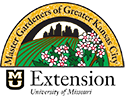Hotline: 816.833.TREE (8733)

-
Aug
15
Harvesting Winter Squash
Summer squash such as zucchini and scallop are harvested while immature but winter squash such as acorn, hubbard and butternut are harvested later, in the mature stage, after the rind is tough and seeds have developed. We normally think September...
Continue Reading → -
Aug
4
Vegetables: Fall Gardens
This is the time of year we normally think of planting a fall garden. Crops that can be planted now include lettuce, radishes, spinach, and similar crops. There still is time to raise another crop of green beans along with some...
Continue Reading → -
Jul
27
August Gardening Calendar
OrnamentalsWeeks 1-4: Continue spraying roses that are susceptible to black spot and other fungus diseases.Weeks 1-4: Annuals may appear leggy and worn now. These can be cut back hard and fertilized to produce a new flush of bloom.Weeks 1-4: Deadhead...
Continue Reading → -
Jul
25
21st Annual Master Gardener State Conference
Final days for big savings in registration for 21st Annual Master Gardener State Conference! This conference is open to anyone interested in gardening. Bring a spouse or friend and enjoy the hospitality of Kansas City. Early Bird Rate ends on July 31st...
Continue Reading → -
Jul
25
Gardeners Gathering
Thursday, August 18, 2016 “Annual and Perennial Weed Families and How to Send Them Packing” The Master Gardeners of Greater Kansas City present: " Annual and Perennial Weed Families and How to Send Them Packing” Thursday August 18, 2016, 6:30 pm...
Continue Reading → -
Jul
18
Weird Squash, Cucumbers or Melons
Occasionally we receive a call from someone who has a squash (or cucumber or melon) that just doesn’t look like what was supposedly planted. They often wish to know if that fruit had cross-pollinated with another vegetable close by. In...
Continue Reading → -
Jul
11
Blossom End Rot
If you have tomatoes with a sunken, brown leathery patch on the bottom of the fruit, you probably have blossom end rot. Though most common on tomatoes, blossom end rot can also affect squash, peppers and watermelons. Not a disease,...
Continue Reading → -
Jul
11
Hornworms on Tomatoes
Hornworms are the largest larval insect commonly seen in the garden. Though usually seen on tomato, they can also attack eggplant, pepper, and potato. The larval stage of this insect is a 3 ½- to 4-inch long pale green caterpillar with...
Continue Reading → -
Jun
8
Flowers: Sidedressing Annual Flowers
Modern annual flowers have been bred to flower early and over a long period of time. They are not as easily thrown off flowering by high nitrogen levels as vegetables are. As a matter of fact, providing nitrogen through the...
Continue Reading → -
May
16
Making Hummingbird Nectar
Making your own nectar couldn’t be easier. In a few easy steps, you can bring these nectar-loving birds to your feeder.Materials:1/4 cup of refined white sugar1 cup boiling waterbowlspoon Important: Don’t use honey; it can promote dangerous fungal growth. Organic, natural and...
Continue Reading →









